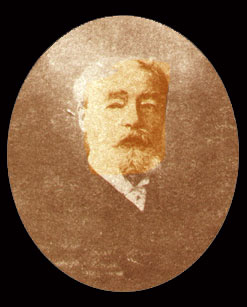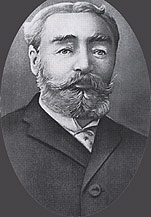

MAX ARTHUR MACAULIFFE (September 29, 1837-March
15, 1913)
'I bring from the East what is practically an
unknown religion.' With these words Macauliffe began his famous and enduring work
The Sikh Religion, published in six volumes by the Clarendon Press in 1909. The
Sikhs,' he continues, 'are distinguished throughout the world as a great military
people, but there is little known even to professional scholars regarding their
religion.' Macauliffe's mission was to remedy that lack of knowledge and understanding.
The Sikh Religion was a work which had involved for him more than fifteen years
of labour, most to it carried out at his residence in Amritsar. It had also produced
a series of disappointments, as his persistent efforts to gain patronage from
the Punjab government met with either a parsimonious response or by the total
rejection. Macauliffe died four years later, an impoverished and bitter man, recognition
denied and his objectives unrealized.
Yet had his objectives been frustrated?
He may have died without recognition, but, The Sikh Religion is still widely read
almost one hundred years later. The group of Sikhs with whom he was closely associated,
and whose ideals he reflected in his writing, propounded an interpretation of
the Sikh religion and community which has ever since steadily gained ground. Today
it commands the allegiance
of most Sikh scholars and the implicit acceptance
of most members of the Panth (the Sikh community). It is also the view of the
Sikh religion and Panth which most foreign observers assume to be the correct
one. The Sikh religion is a completely independent religion in its own right;
and Sikhs of the Khalsa are the only orthodox and sufficient representatives of
that faith. Macauliffe's work has played a considerable part in this process.
He may have died unfulfilled, but fulfillment in abundance has certainly followed
his death.
This being the case the paucity of scholarly studies of Macauliffe's
contribution comes as a surprise. Harbans Singh has contributed a study of his
life, very admiring and very brief.1 The respectful nature of the treatment is
entirely understandable, for Harbans Singh comes from the school of scholars who
were raised on Tat Khalsa principles and who had learnt to cherish the contribution
of Macauliffe. The Tat Khalsa (the 'pure' Khalsa) was the radical section within
the Singh movement, the reformist group which during the latter decades of the
nineteenth century and the first two of the twentieth succeeded in imparting a
new spirit and a new interpretation to the Panth. It was with members of the Tat
Khalsa that Macauliffe had been particularly associated and it was entirely natural
that his memory should be greatly venerated by its later descendants.

This
veneration makes it difficult for those who have been raised on Tat Khalsa principles
to critically evaluate his work, though it can produce a lively account of his
life story. Harbans Singh produces just such an account. It means, however, that
we are left with only one brief work which digs deeply into the sources relating
to Macauliffe's career and which produces an accurate assessment of his contribution.
This is a chapter by N.G. Barrier in a collected work, the chapter entitled Trumpp
and Macauliffe: Western students of Sikh history and religion.2 Professor Barrier
is currently working on a book dealing with Singh Sabha period in Sikh history
and we can expect that his highly perceptive insights concerning Macauliffe will
be contained within it.
Macauliffe was born in Ireland in 1837 and received
his schooling in Limerick, followed by Queen's College, Galway. In 1862 he joined
the Indian Civil Service and was posted to the Punjab. None of the sources which
I have seen mentions a wife. In 1882 he became a Deputy Commissioner and two years
later was appointed a Divisional Judge. There is no evidence that he was interested
in the work of the orientalists located in Lahore, though he may well have nutured
a curiosity in the beliefs of the people for whom he wasresponsible. His one published
work from this early portion of his career was a description of a visit to the
major shrine of the semi-legendary saint Sakhi Sarvar in the Suliman Mountains.
This produced an article in an 1875 issue of the Calcutta Review,3 a descriptive
work which indicated the author's interest in his subject but seemed well removed
from his later fascination with the Sikhs.
In 1880-1, however, there appeared
a series of articles in the same journal which indicated that the fascination
had now gripped him. The first of these articles was The Diwali at Amritsar',
followed soon after by The Rise of Amritsar and the Alterations of the Sikh Religion'
and The Sikh Religion under Banda and its Present Condition'. These marked an
important stage in Macauliffe's development, though all the views which they expressed
were not yet those which characterized his later life.
In some senses though
they were indeed the same. Macauliffe had become aware of the importance of the
Sikh people and these articles manifested a desire to understand them which was
never to leave him. They were a people who were not understood by their British
rulers and Macauliffe was concerned to impart an understanding to them and to
other westerners who shared an interest in these remarkable people.
Macauliffe
also showed both the strengths and what may by regarded as the weaknesses of his
approach. Possessing a fluent pen he was able to present his material in a very
attractive manner. He was not particularly strong in terms of linguistic ability,
though later he was able to overcome this to a considerable extent by circulating
his translations amongst a group of traditional Sikhs whom he had gathered to
help him in Amritsar. At this stage there was no pretence at original scholarship.
Macauliffe utilized the contributions of other writers on the Punjab (men such
as M'Gregor and Cunningham) and set down for the enlightenment of his readers
what he believed to be the truth concerning these inadequately understood people.
In
these respects he was generally in accord with the approach which was to underlie
his later work. In other respects, however, his views differed from what they
were to become. In his early opin-ions Macauliffe shared the current view that
Nanak was strongly influenced by his Hindu background and that the Gurus were
not endeavouring to separate the Sikhs from their Hindu roots. This was a view
that he was later to renounce, but in the early 1880s he still held it. He still
regarded Sikhism as evolutionary, with the deci-sion of Guru Gobind Singh to establish
the Khalsa being a responseto the physical dangers confronting his people. It
represented a be-lief which the Brahmans regarded as heretical. Just as they had
suc-ceeded in swallowing up Buddhism, so too the Brahmanical boa constrictor was
winding its coils around Sikhism and would even-tually squeeze it to death. The
boa constrictor proved to be a fa-vourite symbol for Macauliffe, though the nature
of the intended victim was to undergo significant change.
This was the condition
in the early 1880s. Macauliffe's opinions however, were rapidly changing, and
the principal cause was his association with a group of Sikhs who firmly believed
that the conventional interpretation of the Sikh religion was altogether mistaken.
These Sikhs, as we have seen, belonged to the Tat Khalsa. In 1873 some Sikhs had
become alarmed at what they regarded as the threatened status of the Panth and
had met in Amritsar to form the Singh Sabha. The dominant group within Amritsar
comprised those who wanted reform but reform along the inclusive lines which characterized
the Sikhism of earlier days. The Sikhism which they favoured was one which drew
inspiration from the Vedas and Hindu epics, and no clear difference between Sikhs
and Hindus was recognized. Even the worship of idols was acknowledged if people
who called themselves Sikhs wished to practise it.
These were the group which
came to be called the Sanatan Sikhs, conservative in their views and harking back
to the Sikhism they had known. They were soon to be confronted by the Tat Khalsa,
radical Sikhs centred in Lahore and influenced by western education. Sikhism was
for them not an inclusive faith. It was definitely exclusive. Guru Nanak had founded
the faith as an entirely separate and independent one, in no way dependent on
Hindu tradition. One of the most prominent members of the Tat Khalsa, Kahn Singh
Nabha, compiled a book of proof texts and in 1898 issued it under the title Ham
Hindu Nahin, 'We are not Hindus'.5 Kahn Singh was not only a prominent member
of the Tat Khalsa. He was a also close friend of Macauliffe's and an intimate
adviser as Macauliffe's opinions of the Sikh religion took final shape.
In
1893 Macauliffe resigned his position with the ICS, resolving to devote his labours
to a reliable translation of the Adi Granth (the Guru Granth Sahib, the sacred
scripture of the Sikhs). A translation had earlier been commissioned by the Punjab
government and the task had been entrusted to the German missionary and linguist
Ernest Trumpp. In 1877 Trumpp's partial translation appeared as Adi Granth or
the Holy Scriptures of the Sikhs, together with five lengthy
prefatory essays.
Partly because of the wooden nature of his translation, but more particularly
because of his outspoken and insulting comments, Trumpp's work never won acceptance
among the Sikhs. To the Tat Khalsa it was anathema in that it laid firm stress
on what Trumpp regarded as the clear evidences of Hindu influence. A reliable
translation would have to be provided in its place and this Macauliffe set himself
to do.
He gathered around him a selection of traditional scholars of the Adi
Granth and set to work, circulating portions of his translations to his informants
and revising his drafts in accordance with their suggestions. As the work proceeded
Macauliffe widened the scope to include narratives to the lives of the ten Gurus,
together with those of the Bhagats.6 For these he also relied upon the interpretation
of those with whom he was closely associated, with the result that his final work
mirrors exactly the views of the Tat Khalsa reformers. Sikhism was no longer to
be seen as an outgrowth of Hindu tradition. There were certainly features within
it which Hindu India also acknowledged (notably a belief in transmigration), but
the Sikh faith should be viewed as an entirely new religion, distinguished be
superior beliefs and a high ethical content.
Macauliffe issued the results
of his work to date in a brief essay which he published at the turn of the century.
In The Holy Writings of the Sikhs he produced the form which he would later be
following in The Sikh Religion, presenting Guru Nanak as the founder of a new
religion.7 This was followed by more essays. In the first of these he commended
the Sikhs to the British as potential allies;8 and in the second presented the
Tat Khalsa concept of a heroic determination to fight as the safeguard of the
faith against Mughal intolerance.9 Meanwhile he also published selections of the
translations which he was making from the Adi Granth and also the life of the
ninth Guru.10
Finally the great work which Macauliffe had been preparing was
ready for the press. In 1908 the manuscript of Tlie Sikh Religion: Its Gurus,
Sacred Writings and Authors was delivered to the Clarendon Press and Kahn Singh
Nabha, his dose associate, accompanied him to England to help check the proofs.
The work was finally published in 1909 as six volumes bound in three.11 In Professor
Barrier's words, 'Macauliffe gave Sikhs and the world a readable, popularized,
but very uncritical account the early evolution of Sikhism'.12 It may have been
very uncritical (it undoubtedly was), but its influence has been profound. No
other work has so effectively instructed western readers about Sikhism,with the
result that the Tat Khalsa interpretation of the Sikh faith and community has
been firmly fixed in the western understanding. The Sikh religion is a unique
religion and the Khalsa represents its true form. Any attempt to demonstrate that
the situation is rather more complicated than this must expect to encounter rugged
opposition.
For Macauliffe the publication of The Sikh Religion marked the
latest in a catalogue of little help or outright rejection. The Punjab Government
and the Government of India refused to sanction the work and the latter's offer
of a contribution of Rs. 5,000 was indignantly rejected as paltry in the extreme.
Sikhs were loud in their praises, but fearing the loss of government patronage
the wealthy amongst them held back from financial donations. The result was that
Macauliffe had to spend a considerable sum from his own pocket in order to see
the work through publication.
Macauliffe died at his London home at Sinclair
Gardens in West Kensington on 15 March 1913, a disappointed man. His hopes and
purpose had been clearly expressed in the words with which he closed the essay
on 'How the Sikhs became a militant people':
Such
are the deeds that have been done, the prophecies that have been uttered, and
the instruction that has been imparted by that great succession of men, the Sikh
Gurus. In them the East shook off the torpor of ages, and unburdened itself of
the heavy weight of ultra-conservatism which has paralysed the genius and intelligence
of its people. Only those who know India by actual experience can adequately appreciate
the difficulties the Gurus encountered in their efforts to reform and awaken the
sleeping nation. Those who, removed from the people and dwelling in the lofty
and serene atmosphere of their own wisdom and infallibility, deem Sikhism a heathen
religion, and the spiritual happiness and loyalty of its professors negligible
items, are men whose triumph shall be short-lived, and whose glory shall not descend
with the accompaniment of minstrel raptures to future generations. I am not without
hope that when enlightened nations become acquainted with the merits of the Sikh
religion they will not willingly let it perish in the great abyss in which so
many creeds have been engulfed.13
Notes
1.
Harbans Singh, 'English Translation of the Sikh Scriptures-An Arduous Mission
of a Punjab Civilian' in K.S. Bedi and S.S. Bal eds, Essays on History, Literature,
An and Culture, (Delhi: Atma Ram & Sons, 1970), pp. 139-44.
2. Historians
and Historiography of the Sikhs, ed. Fauja Singh (New Delhi: Oriental, 1978),
pp. 166-85.
3. The Fair at Sakhi Sarvar', Calcutta Review, Vol. uc (1875),
pp. 78-101. For an account of Sakhi Sarvar and of the importance of the cult in
the late nineteenth century see Harjot Oberoi, The Construction of Religious Boundaries:
Culture, Identity and Diversity in the Sikh Tradition (Delhi: Oxford University
Press, 1994), pp. 147-60.
4. Calcutta Review, Vol. uoci (1880), pp. 257-72;
Vol. LXXII (1881), pp. 48-75; and Vol. um (1881), pp. 155-68.
5. For an excellent
account of the division within the Singh Sabha see Harjot Oberoi, The Construction
of Religious Boundaries, particularly Part II.
6. The Sant poets whose works
also appear in the Adi Granth.
7. The Holy Writings of the Sikhs (Allahabad:
Christian Association Press, 1900), p. 30.
8. A Lecture on the Sikh Religion
and its Advantages to the State (Simla: Superintendent, Government Central Printing
Office 1903), p. 28. Reprinted in M. Macauliffe, et. al., The Sikh Religion: A
Symposium (Calcutta: Susil Gupta, 1958), pp. 1-53.
9. How the Sikhs became
a Militant People (Paris: Ernest Leroux, 1905). Reprinted in The Punjab Past and
Present, Vol. xvi-n (October 1982), pp. 484-504.
10. The portions which were
published were Japji, Rahiras or the Evening Prayer of the Sikhs, Anand and the
Sabd of Guru Amar Das, The Arati and Sohila of the Sikhs, and Asa di Var, published
between 1897 and 1902. His Life of Guru Teg Bahadur (Lahore: author) followed
in 1903.
11. The same Gurmukhi font, apparently fashioned in wood, which was
used for the Adi Granth quotation on the title page was later used on the dedicatory
page of my Guru Ndnak and the Sikh Religion, published by the Clarendon Press
sixty years later. In 1968 the font presented a dated but thoroughly satisfying
impression.
12. N.G. Barrier in Historians and Historiography of the Sikhs,
ed. Fauja Singh (New Delhi: Oriental, 1978), p. 184.
13. Macauliffe, 'How the
Sikhs became a Militant People', in The Panjab Past and Present, Vol. xvi-n (October
1982), p. 504.